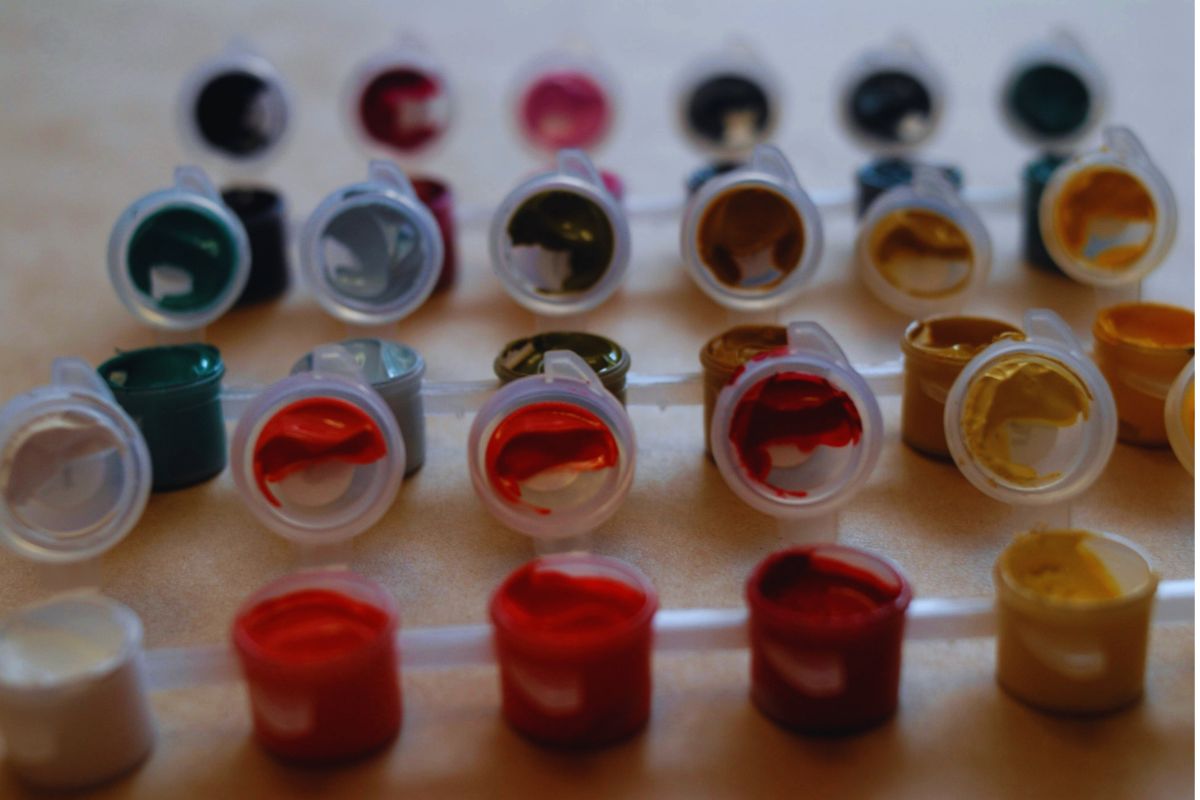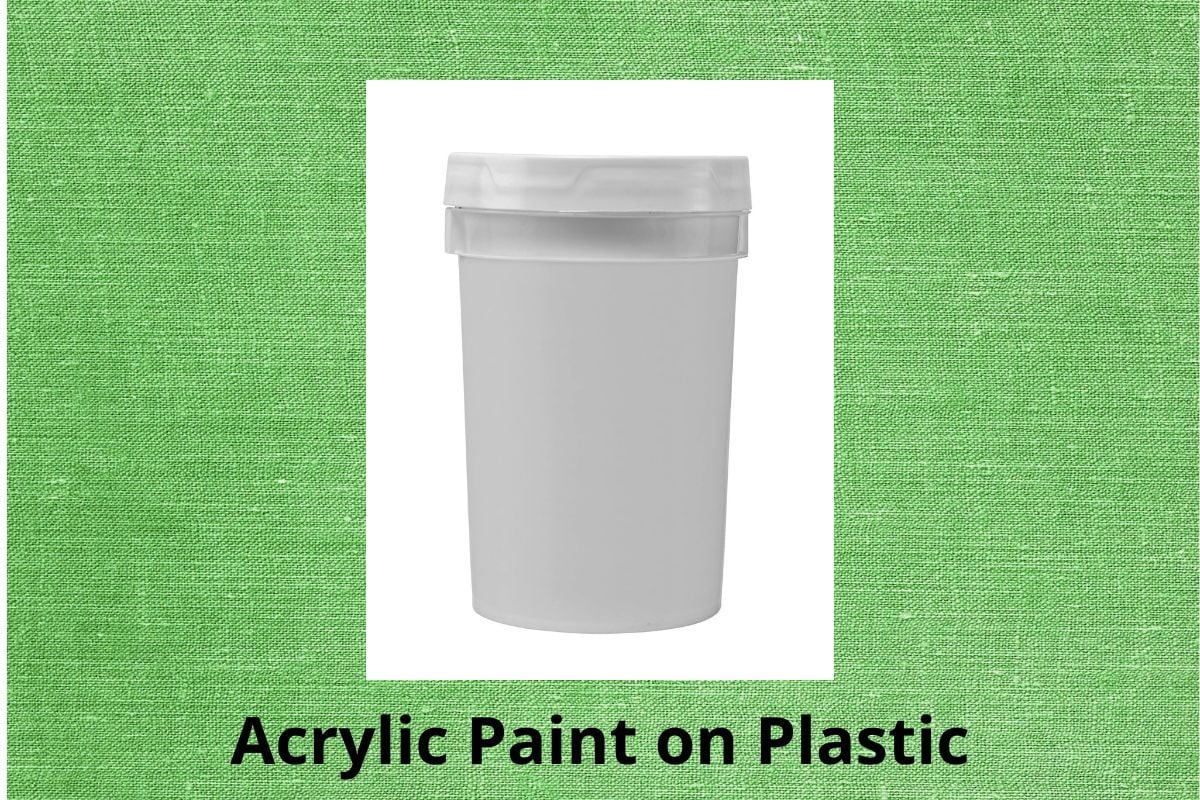Randy Charles is the owner of PaintCentric.com, a website dedicated to providing information, tips, tricks, and news about all things paint. With over 10 years...Read more
Why Does Acrylic Paint Not Stick to Plastic?

To understand why acrylic paint does not stick to plastic when you are trying to paint plastic with acrylic paint, we need to examine the properties of plastic that make it difficult to bond with acrylic paint. Additionally, it’s essential to consider what happens when you try to paint plastic with acrylic paint to provide the best solution for how to paint plastic with acrylic paint.
Properties of Plastic that Make it Hard to Stick with Acrylic Paint
Acrylic paint is widely used on various surfaces but has difficulty adhering to plastic due to specific properties. Low surface energy, slickness, and no porosity make it hard for the paint to stick. Plus, plastic can be treated with chemicals during production, affecting its ability to bond with acrylic paint.
If you want acrylic paint to stick to plastic, here are some suggestions:
- Clean and dry the plastic thoroughly.
- Use an adhesion promoter before painting.
- Sand or etch the plastic surface lightly.
Painting plastic with acrylic is like trying to make a snowman in the desert – it just won’t stick.
Checkout the best spray paint for plastic here.!
What Happens When You Paint Plastic With Acrylic Paint?
Acrylic paint has trouble adhering to plastic surfaces. Plastic is non-porous and doesn’t let the paint stick well. As a result, it can easily flake off or peel.
To paint plastic successfully, there are four steps to take:
- Clean and dry the plastic before painting.
- Use a primer designed for plastic to increase adhesion.
- Let the primer dry before applying acrylic paint.
- Consider the type and quality of primer used and the painting technique used.
An article by ScienceDirect.com mentions that improving adhesion properties with plasma treatment and UV irradiation is possible.
So remember, plastic surgery may give you a new face, but plastic needs proper preparation to get a new paint job.
Prepare Plastic for Acrylic Paint

To prepare plastic for acrylic paint, you need a solution. With “Preparing Plastic for Acrylic Paint” with “Cleaning Plastic before Painting, Sanding Plastic Surface, and Applying Primer on Plastic,” you can paint plastic surfaces with acrylic paint. These sub-sections offer the necessary preparation to ensure your acrylic paint adheres smoothly to plastic.
Clean Plastic before Paint
To create a smooth plastic surface, sand it with a fine-grit sandpaper. This helps create a rougher texture for better paint adherence.
Before painting, plastic surfaces must be adequately prepared. Clean the plastic with a gentle cleaner or soap and water solution – avoid harsh agents.
Dip a sponge in the solution and wash the surface thoroughly. Rinse it with warm water and wipe it with a dry cloth or towel.
The plastic surface must be arid before applying acrylic paint. Any moisture left can cause issues like cracking, peeling, or fading.
Sanding Plastic Surface
Surface Sanding for Plastic is refining plastic texture to achieve a smooth surface before painting. Here are three simple steps to get it done:
- Clean the plastic cover with warm soapy water to remove dirt and grease.
- Rub the surface gently with sandpaper, using a 240-320 grip level.
- Rinse and dry thoroughly before starting with acrylic paint.
Chemical solvents should be avoided, as they can damage the plastic texture. Without proper sanding and cleaning, acrylic paint won’t stick permanently.
ArtisPaints.com sources say, “90% of successful work is due to proper surface preparation.”
Apply Primer on Plastic
Putting down a base coat on plastic before painting with acrylics is critical. Here’s a guide to doing it right!
- Wash the plastic surface with warm water and soap.
- Fully dry with a clean towel or cloth.
- Get a quality primer that’s meant for your plastic type. Check if it’s compatible with acrylics.
- Shake the primer can for two minutes or read the instructions.
- Spray an even coat of primer onto the plastic surface in a well-ventilated area, 6 inches away.
- Let it fully dry – 24 hours recommended.
Tip: Multiple thin coats are better than one thick one. Don’t touch-dry objects before they’re scorched.
Be sure to get a suitable primer for your plastic! Follow these steps for a perfect finish.
Steps to Follow to Paint Plastic with Acrylic Paint
To paint plastic with acrylic paint, you need to follow specific steps. The main aspects to consider are choosing the correct type of acrylic paint, paying attention to drying time and curing period, and applying acrylic paint on plastic. In this section, you will learn how to paint plastic with acrylic paint effectively by exploring the sub-sections in detail.
Choose the Correct Type of Acrylic Paint
Picking Acrylic Paint for Plastic
To paint plastic, you must find the right acrylic paint that sticks to it. Cleaning and prepping the surface is essential for the paint to bond correctly. To avoid cracking, apply thin layers instead of thick ones.
How to Choose:
- Look for paint designed for plastic.
- Go for water-based acrylic paint, not oil-based.
- Think about using a spray primer made for plastics.
- Choose light colors if you’re painting dark plastic.
- Test the paint and plastic surface in a small area.
- Read and follow the instructions for the product.
Pro Tip: Don’t forget to clean and prepare the plastic. And don’t use paint that isn’t compatible.
Waiting for the color to dry? It’s like watching paint dry…but fun!
Dry Time and Cure Period
When painting plastic with acrylic paints, it is essential to know the drying and curing times. Drying refers to when the surface layer becomes dry. Curing is when the color is sufficiently complex and durable. The table below highlights drying and curing times for different types of acrylic paint on plastic surfaces at room temperature.
| Type of Acrylic Paint | Drying Time | Curing Period |
|---|---|---|
| Water-based | 1-2 hours | 48-72 hours |
| Solvent-based | 2-3 hours | 5-7 days |
| Artist-grade Acrylic | 20-30 minutes | 24 hours |
Remember that these times can vary based on humidity, the thickness of paint applied, and environmental conditions. Don’t rush – premature handling or exposure before a complete cure can damage the plastic. Wait at least seven days before heavy use.
I once used an inferior quality paint that claimed to dry in an hour but took two days instead. Disappointed, I tried to scrub it off – only to find it was completely cured after two weeks! Since then, I always wait for the proper drying and curing times. Patience pays off!
Apply Acrylic Paint on Plastic
Surprisingly, acrylic paint can be used to paint plastic objects with the proper steps. To do it correctly:
- Clean the plastic surface well to get rid of oil or dirt.
- Use a primer made for plastics. This will help the paint stick.
- Once the primer is dry, put on the acrylic paint in thin layers. Let each layer dry before adding the next.
Moreover, some plastics may call for extra steps, like sanding or using a glue promoter.
A pro tip: Use gentle pressure when applying the acrylic paint not to crack or peel when dry. For an untraditional approach, try melting crayons and using a blowtorch!
Alternative Methods to Paint Plastic
To paint plastic with acrylic paint, you need special preparations that can be time-consuming and hard to find. Instead, you can explore alternative ways to paint plastic with spray, oil-based, or enamel paint. This section will introduce these sub-sections to paint plastic without acrylic paint.
Use Spray Paint on Plastic
Tired of dull plastic surfaces? Ready to unleash your inner Bob Ross? Spray painting plastic is a great way to make your plastic items shine! Here’s a 6-step guide to get you started:
- Start with a thoroughly clean and dry
- Use a primer designed for both plastic and spray paint
- Apply primer thinly and let dry
- Spray paint in even strokes
- Avoid blotches with multiple thin coats
- Allow the final coat to dry before use
Protective gear is a must when spraying – gloves, goggles, and masks. And don’t forget to read all warnings before beginning. Use paints with urethane or acrylic resins for plastic that flexes or bends.
To achieve a smooth finish on uneven surfaces, lightly sanding the surface helps the primer stick. Use higher-grit sandpaper (320-400 grit) for bumps or ridges.
Ready to get painting? Follow these guidelines, and you’ll be surprised at the excellent results! Investing in fantastic paint upkeep is well worth it.
Use Oil-Based Paint on Plastic

If you want to paint plastic with oil-based paint, there are a few things to consider. Firstly, clean the plastic surface with soap and water. Then, lightly sand the surface with fine-grit sandpaper to help the paint stick better. After that, apply a coat of primer. It will provide a good base for the paint and make it last longer.
Also, when picking paint, go for an enamel or epoxy. Use a brush or spray paint for easy application or high-pressure airless spraying for larger surfaces. Please ensure all solvent fumes are gone, as they can be harmful.
Pro Tip: Allow ample time for drying between coats to avoid scratching or chipping off fresh paint. Who needs a face-lift when a bit of enamel paint can give plastic a new lease on life?
Use Enamel Paint on Plastic
Enamel Paint gives plastic surfaces a durable finish and strong adhesion. But how do you use it properly? Here are some steps:
- Clean the plastic cover with soap and water, rinse it, then dry it.
- Sand the whole area with fine-grit sandpaper for a smooth finish.
- Apply a primer coat with even strokes.
- Once the primer is dry, apply enamel paint in thin layers. Let each layer dry before adding another.
- For extra protection, add decorative finishes or clear coats.
Important Reminder: When using enamel paint on plastic, use proper ventilation and protective gear like gloves and masks. Don’t apply too much pressure when sanding, as this can damage the plastic.
Pro Tip – Before painting a large area, do a patch test to check the paint and plastic material compatibility. Painting plastic can be tricky – these tips and tricks will help you succeed!
Tips and Tricks to Achieve Best Results
You must follow some tips and tricks to achieve the best results by painting plastic with acrylic paint. Proper ventilation, using brushes and rollers carefully, and wearing protective gear while painting can help make the painting process easier and more efficient. Let’s dive into each of these sub-sections to learn more.
Use Proper Ventilation
Ventilating To Achieve The Best Outcome
Good ventilation is vital for any room. Make sure air can circulate easily. Achieve this by opening windows or adding an exhaust fan. Appliances can also impact air quality, so use them with caution.
Keep temperature and humidity at the right level. Optimal performance requires 18-21°C and 30-60% relative humidity. Also, regularly change filters on your HVAC system.
Enclosed spaces such as bathrooms and kitchens are especially prone to bad air. Install exhaust fans and open windows to avoid mold and mildew buildup.
Poor indoor air quality can cause allergies, asthma, and other respiratory issues (source: EPA). Proper ventilation helps you get great results and creates a healthy environment.
Finally, finesse is critical when using brushes and rollers – not turning walls into a kindergartner’s art project.
Use Brushes and Rollers Carefully

Using Painting Tools the Right Way!
Proper use of painting tools can give you the perfect outcome. Here’s how to use your brushes and rollers carefully:
- Clean the surface before you start painting.
- Pick the right brush or roller for the job.
- Even pressure while you paint. No drips or smudges!
- Wait for each coat to dry before you apply the next.
Plus, always clean your brushes and rollers after use. This will help them last longer and save you time too!
Fun Fact: Sherwin Williams states high-quality brushes and rollers make painting more accessible and help you get a smooth finish.
Protective gear might not be stylish, but it’s much better than a trip to the hospital with paint in your eyes and mouth!
Wear Protective Gear While Painting
Don’t forget to wear protective gear before painting! Goggles, gloves, coveralls, and masks are a must for keeping yourself safe from hazardous fumes, dust, and paint splatters. Different colors require different protective gear, too – oil-based paints need respirators to protect against toxic vapors. Working outdoors or in well-ventilated spaces also helps to minimize inhalation risks.
Advancements in tech have provided us with more elaborate equipment, such as powered air-purifying respirators (PAPRs). This pumps fresh air directly into a headpiece while painting. Don’t compromise your health – wear the proper gear throughout the job. That way, you protect yourself and anyone around you.
Conclusion:
Acrylic paint and plastic don’t stick? No worries! Sand the plastic surface with fine-grit sandpaper. Clean it thoroughly. Then, apply a special plastic primer. This will help create a strong bond for the acrylic paint.
Remember: not all plastics are suitable for painting. Check what type of plastic you have. Different kinds require different primers. Make sure you use top-notch paints that match your desired color and texture. Follow the drying instructions in the paint’s guide. You’ll need knowledge about how certain materials work together for a successful paint job.
Watch out for dangerous chemicals during the preparation process.
Frequently Asked Questions
How to paint plastic with acrylic paint?
First, clean the plastic thoroughly with soap and water, then dry it completely. Next, sand the plastic lightly to create a slightly textured surface for the paint to adhere to. Apply a plastic primer, followed by two thin coats of acrylic paint, allowing each coat to dry completely before applying the next one.
Can you paint plastic with acrylic paint?
Yes, you can paint plastic with acrylic paint, but following the correct preparation and application process is essential to ensure the paint adheres and lasts well.

Randy Charles is the owner of PaintCentric.com, a website dedicated to providing information, tips, tricks, and news about all things paint. With over 10 years of experience in the painting industry, Randy has become an expert in the field and is passionate about helping others learn more about painting. He has written numerous articles on the subject and is committed to providing accurate and up-to-date information to his readers.
- Latest Posts by Randy Charles
-
How Much Do You Tip Painters? The Ultimate Guide
- -
Can You Paint Over Rust Converter?
- -
Can You Paint Inside When It Is Raining?
- All Posts
